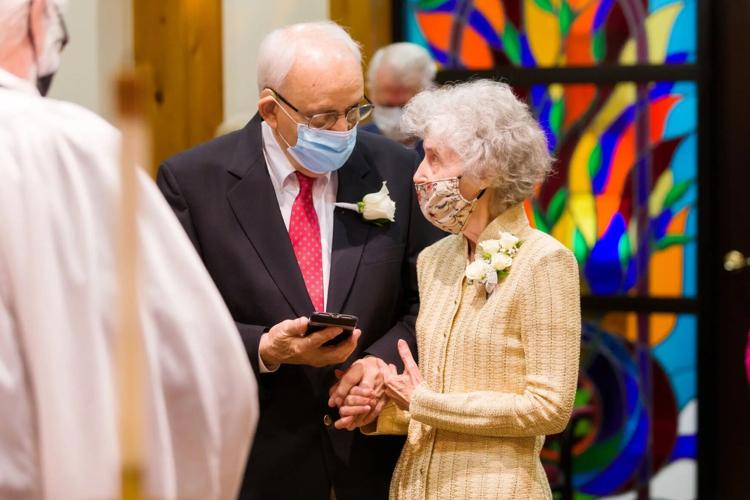Sam Gallo, a 95-year-old Baton Rouge resident, was born in Schenectady, New York.
After graduating high school, following a short employment at the General Electric Company, he entered the U.S. Air Force. After he left the Air Force, his work with the Glenn Falls Insurance Company took him to Chicago, Dallas and finally Baton Rouge.
In retirement, Gallo uses technology to communicate as he is deemed legally deaf related to service in the military.
Gallo served as the 1987 national chair of the Board of the American Diabetes Association. He is the founder of the National Diabetes Alliance, Diabetes America and the Louisiana Diabetes Foundation. He was the 1987 recipient of the Dr. Charles H. Best Award for Distinguished Service given by the American Diabetes Association.
In 2020, Gallo, a widower, met his wife, Millie, at the St. James Place retirement facility. They were married in the height of the pandemic. He has three adult, married children.
He is a man of many talents, including holding U.S. Patent #4,078,356 (also registered in 10 foreign countries) for his work developing a method to substitute an inert gas for oxygen in coffee "singles" packages at speeds of 450 units per minute.
In 2023, Gallo was diagnosed with Grover’s disease, an uncommon and painful skin disease that presents as an itchy rash. In keeping with his success with the American Diabetes Association, Gallo wants to bring more awareness to the little researched disease.
Tell me about contracting Grover's disease.
In December of 2023, I got Grover's disease. Both Millie and I said: “What's Grover's?” Because she has never heard of it. I never heard of it. We started looking for Grover’s and we couldn't figure it out. We couldn't find out anything about it.
I called the National Academy of Dermatologists, and I started to inquire about it. They have an alphabetical list of all the diseases that the academy messes with, but Grover’s isn’t on the list.
The reason that it's not a big enough deal is that Grover's is not fatal, and for some strange reason they haven't figured it out yet. There’s no cure. It eliminates itself. It reduces itself between six months and a year. I'm in my ninth month, and it's almost gone.
Talk to me about the Facebook support groups; have they been helpful?
When you have Grover's, you have to quell the itch. You can't sleep. At first, it's almost impossible to sleep.
On Facebook somebody said, “This is what you should use.” Everybody concocts their own lotion.
Thank God for Millie. Every morning after my shower, I sit in a chair and she helps me put on the lotion. I'm like all greased up.
Grover's is going on all over the world.
How are you trying to raise awareness for Grover's disease?
In any kind of health matter, you have to have a centralization of data. I don't care what the disease is. You can't have somebody doing something here and somebody doing something there, and this person doesn't know what this person's doing.
I started looking around for Grover's — and there was nothing.
So, I designed a website. It's very simple. I got two domains out of pocket, including one for the American Grover's Disease Association.
The final key was to create a corporation with a 501(c)(3) IRS designation. I did that. The application fee alone is $250.
No one visits the site. It was a complete failure. Nobody's interested. Nobody.
When you go to a dermatologist, there's a rack with all the different brochures. They don’t have one for Grover's. I want to create one for Grover’s.
It's gonna take money, because I feel like step one is to put the Grover's pamphlet in all the dermatology offices.
Tell me about the American Diabetes Association and your work with them.
That was one of the things that I got involved with because of my daughter Elizabeth, who became a diabetic at a very early age — 5 years old.
Because treatments were scarce, diabetes was really bad then. They hadn't really developed the better ones treatments than NPH, a type of insulin.
I started a statewide association in Louisiana because it bothered me that there wasn't anything about diabetes in Louisiana.
There was no centralized research or directed focus shared among organizations. I pitched the idea of centralizing in Louisiana — it was hard. We had to travel because some of these cities had little diabetes support groups that were very patient-oriented. They were very valuable, because after Elizabeth got diabetes, we started visiting young kids and giving them support.
I brought them together and created Louisiana Diabetes Association. It didn't have anything to do with national group. I just was doing it, and it blossomed really big.
We had our first convention in Baton Rouge at that motel that used to be over by the old Our Lady of the Lake that they tore down.
It was a very big success. A lot of people came and money was coming in. We rented space, we hired an executive director and a couple of volunteers.
We ended up creating the theme: "One state. One affiliate." I started traveling around the United States, selling that message.
I got involved with the American Diabetes Association, and through my work, I became the national chairman. Then I got asked to be put on the board of the National Diabetes Advisory Board, which is a congressional committee.




